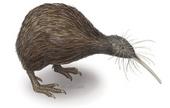|
The Wekas, or woodhen, is endemic to New Zealand.The Wekas, or woodhen, is endemic to New Zealand. This flightless bird species is a strong brown bird and a member of the rail family. Four subspecies are recognized: the Buff Weka, the Western Weka, the North Island Weka and the Stewart Island Weka.
They are a rich brown color with mottled black and grey markings. The beak is about 5 cm long and is a beautiful reddish-brown color. It is often used as a weapon and since it is long, stout and tapered, it works quite well as such. They are relatively small birds, about the size of a chicken. Sturdy legs, reduced wings and a pointed tail that is almost always moving, are other distinct characteristics. A male would weigh in around 1 kilogram and 50 centimeters in length. The female is smaller, coming in around 700 grams. They are very curious and feisty birds. They are omnivores, which means they enjoy eating fruit, small animals, and various plant foods. Their diet consists mostly of plant foods, with the animal foods being more of a supplement. Earthworms, spiders, mice, grubs, snails, insect eggs, berries, grass, leaves, and seeds are just a few things they might eat. They are excellent and essential seed dispersers, as they are able to distribute larger seeds that smaller birds are unable to handle.
They inhabit areas such as sand dunes, rocky shores, forests, sub-alpine grasslands and even semi-urban environments. They have also been known to allow their curious nature to get the best of them and go searching around camps and homes for scraps of food. Both the male and female incubate the eggs, which are laid sometime between August and January. In times when food is plentiful, they can sometimes raise up to four broods in one year. Bowl-shaped nests made from grasses (or other materials that are easily molded) are created on the ground, usually under thick vegetation for safety. The nests are big enough to hold up to four eggs. Eggs are a pretty creamy or pinkish color and are speckled with brown or mauve spots. Chicks hatch after thirty days or so and will be fed by both parents until the age of six to ten weeks, at which time they are considered fully grown.
Wekas are not yet an extinct bird, but are considered vulnerable. Wekas are susceptible to several threats. These include predation of the adults by dogs and ferrets, not to mention the chicks being eaten by cats. Rats will also eat the weka chick eggs. Wekas compete with other like species for their food supply of invertebrates and fruit as well. Much of their habitat is being threatened by the depletion of forests and wetlands. In areas where wekas are living close to humans, many are killed on the road by vehicles.
There are a few other interesting facts about this ratite bird. New Zealand folklore tells tales of weka stealing bags of sugar and shiny items. This bird species was also called a "bush hen" by early European settlers and explorers. The Maori people used wekas as a source of food, oil (for medicinal purposes) and perfume. They also used feathers in their clothing.
Efforts are being made to keep this flightless ratite bird from becoming extinct.
pay per play
this is a weka
|

